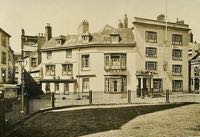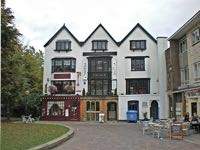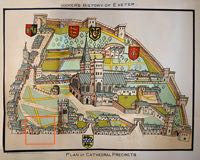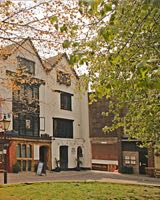
Little Stile
One of the seven ancient gates of Cathedral Close
Page updated 25th October 2016
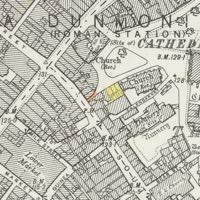 The only gate into Cathedral Yard that is no longer
in existence as a right of way, Little Stile was a postern gate of
approximately 5ft width. It was a route that went from the pathway in
front of the Three Gables, to South Street, with the northern
side bounded by the Globe Hotel. There is a record from a map, of it being
named "Cook Row Street". Cookerow was an alternative name for the top of South Street. It has been suggested that before Cathedral Close was walled and gated, that there was a wide entrance from South Street, into the Close, probably where the Globe Hotel was situated. A document from 1286 describes the gate at that time as wattle and daub or latticework. Later, the passage ran through the middle of a tenement, with two stone vaulted ceilings supported on stone pillars.
The only gate into Cathedral Yard that is no longer
in existence as a right of way, Little Stile was a postern gate of
approximately 5ft width. It was a route that went from the pathway in
front of the Three Gables, to South Street, with the northern
side bounded by the Globe Hotel. There is a record from a map, of it being
named "Cook Row Street". Cookerow was an alternative name for the top of South Street. It has been suggested that before Cathedral Close was walled and gated, that there was a wide entrance from South Street, into the Close, probably where the Globe Hotel was situated. A document from 1286 describes the gate at that time as wattle and daub or latticework. Later, the passage ran through the middle of a tenement, with two stone vaulted ceilings supported on stone pillars.
Repairs over the years
Various repairs to the gate were recorded through the centuries. The gate's lock was repaired in 1418 at a cost of 4d, while the Chapter Act book records that the gate was repaired in 1749, and the steps in 1782. There must have been a problem with people trying to ride or lead horses through what was legally a postern, for in 1689 a record was made that the steps were to be repaired and "...a Turnstile or Post (was) to be set up to hinder the horses from coming into the Churchyard that way, provided it be not prejudicial to the Neighbours."
A survey and valuation of property in 1708, included the Globe Tavern and tenement in Cookerow. The property on the south side was in the possession of Abraham Hole, coffee man, and was "commonly called Males's Coffee-house." The property was described as having a cockloft, three little chambers below, three chambers below them, and "the two coffee roomes open together", John Wills's barbers shop, and a cellar in the possession of Thomas Elliott vintner. To this tenement belonged a little narrow court or passage (Little Stile) leading into the Church-yard, and a back cellar.
According to Jenkins, the passage was blocked in 1805 when he wrote his history of the city. He also wrote that the "Little Style-gate (as) not void of ornaments." Whether that means there was a coat of arms over the gate, or some other decoration, is not known.
A fire in a baker's house quickly spread to several properties and the tenement of Little Stile in 1820. After, the Chapter took the opportunity to increase the width of the gateway to 8ft, and remove the gate, the entrance remained open only to people on foot. The northern side of the original tenement was incorporated into Channon's house, and the southern side leased to William Chesterman to build a new house "...equally good as far as the space will permit." A sign was put up with the inscription "Gate removed 1820. No Passage at night. But by leave of the Dean & Chapter", and a ring fixed to the wall on each side.
The Cathedral archives record that three new timber framed houses each containing a Heavitree stone lined cellar, shop, kitchen and three chambers above, were built on the site of the old workhouse store, by Little Stile. They are now known as the Three Gables. In the 1980's, one was the office of Web & Bower, the publishers of a Country Diary of an Edwardian Lady. They even had the original diary on show in a glass case.
Social History
The Exeter martyr, Thomas Benet nailed a paper protesting against the supremacy of the Pope to the door of the Cathedral in October 1530. He escaped the authorities this time and sent...
"... his boy early in the morning following, to set the sayd billes upon the gates of the Churchyarde. As the boy was setting one of the sayde billes upon a gate called the Little Stile., it chaunced that one W. S. going to the Cathedral church to heare a Masse called Bartons Masse, whych was then daily sayd about 5. of the clocke in the morning, founde the boye at the gate, and asking him whose boy he was, did charge him to be the heretike..." John Foxe, Book of Martyrs.
The boy was caught and Benet was captured by the Cathedral authorities. He refused to submit to the Pope and was burnt at the stake for heresy on 10 January 1531.
Richard Parker, who was hanged as a naval mutineer was born in 1767 in Little Stile. In June 1797, he was involved in a naval mutiny at Sheerness, that was fighting to improve the conditions of British Navy seamen. His father was a baker, and there is a record that he was granted two leases near Little Style in 1779.
The installation of a new, lamp at Little Stile appears to have created considerable discussion with the Commission of Improvement. There had recently been an election in St Mary Major's Ward, and it would seem that some thought there was a connection. Politicians have often promised favours for votes, it would seem.
In May 1847, there were riots across the city, due to the high cost of food. The rioters accused speculators of pushing up the price of corn and potatoes. A crowd swept up South Street, targeting bakers. They turned into Little Stile and broke into Mr Barrett's the baker, and took some bread, before continuing through Cathedral Yard and on to Catherine Street.
The loss of the top of South Street and the Globe Hotel in the bombing of May 1942, led to a new entrance to Cathedral Yard being cut from South Street, across the site of the Globe Hotel. Some of the houses adjacent to the Three Gables survived the bombing, but were removed when South Street was rebuilt, and thus Little Stile was lost. This corner of Cathedral Yard is all the poorer for the loss of the Globe Hotel and Little Stile. True, the Three Gables have survived, but they are framed on one side by the sort of buildings that give Exeter a reputation for not caring for its history.
Sources: Western Times, Flying Post and Exeter and Plymouth Gazette, and Exeter Cathedral Archive, Devon and Cornwall Notes and Queries. Book of Martyrs by John Foxe.
│ Top of Page │
